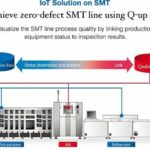Industry 4.0 and automation have been on-going trends that have become more attainable and accessible. The future of the electronics manufacturing industry lies on companies that are willing to invest in the progress of technology. In an interview with Kevin Youngs, the European Sales Manager of Omron Europe’s Automated Inspection Systems Division, he discusses trends and goals the company is striving towards, to reach their vision of the future for all industries, including industrial automation, electronic component, and more. Following their mission of being a pioneer in creating inspired solutions for the future, the company is not only focused on futuristic trends, such as flexible manufacturing, AI, and digital factory, but also to continue to cover all aspects of the production line, including smart vision inspection.
How much does Omron invest in research and development and how many people are employed in this area?
Research and development expense is an important long-term investment for the Omron Group. We have set a standard for R&D expense at 7 % of sales, and we intend to raise this level to 7.5 % by fiscal 2020. Our target for investments in core technologies, including AI and robotics, is about 1 % of sales. Dedicating capital to the progress of technology represents up-front investments that will bear fruit for corporate growth 10 and 20 years down the line. This is the type of investment we must undertake as a manufacturing company, if we are to develop innovations that improve lives and contribute to a better society. Accordingly, we will continue to make bold investment decisions that challenge the frontiers of science, balancing discipline and risk to deliver to the world innovation.
What is the significance of the innovative automation concept?
Manufacturers face many challenges when moving towards an agile and flexible production environment. It is only when they are confident of meeting both the demands set by consumers and the markets that they can begin the journey to truly flexible manufacturing and the ultimate goal of the digital factory. Omron’s complete range of hardware and software products have been designed from the ground up to assist that process by providing the highest levels of integration, highly advanced intelligence capabilities and safe and easy interaction with the complex technology.
To assist manufacturers, the company has launched its innovative-automation (i-Automation) programme, which is intended to provide manufacturers with a consistent, reliable way of ensuring they can meet both consumer demands and the changing needs of industry. i-Automation is based on three ‘i’s – integrated, intelligent and interactive. Together these three pillars can be combined to provide manufacturers with the highest levels of quality, sustainability and operational excellence that will help meet any future demands.
The innovative-automation philosophy is the shortest and quickest route for manufacturers to surpass customer expectations and achieve manufacturing excellence.
Constantly growing demands on component production require preventive, integrated strategies for zero-defect production. What do they look like at Omron?
For many years now, the company has used a process template for back-casting to create innovation driven by social needs. We contribute to a better society by developing technologies and products necessary to achieve near-future design, incubating businesses that become an indispensable part of society.
100 % reliability and achieving zero defect processes are essential for example in electric vehicle and advanced driver assistance systems (ADAS). Therefore, electronic assemblies of automotive PCB processes must meet the highest quality manufacturing standards. To meet these customer needs in PCB optical and X-ray inspection in the SMT process, the company’s solutions guarantee the quality of PCB components and the strength of solder joints. Automatic full inspection offers extremely high inspection accuracy and eliminates defective products and any inspection variations caused by manual work. We provide manufactures with user-friendly in-line inspection machines that can be easily implemented in the manufacturing line, offering reliable and robust performance.
Zero defect production means avoiding the causes of deviation even before the service has been completed. How and what is Omron doing to approach zero-defect production?
The new Artificial Intelligence solution, which is now available, collects, analyzes and utilizes data on ‘edge’ devices within a controller to prolong equipment longevity and detects unforeseen abnormalities to prevent failures. It is the first AI machine automation controller with a Sysmac library, and fuses control functions of manufacturing lines and equipment with AI processing at manufacturing sites in real time.
The process of collecting raw data from machines is completely automated by the new AI controller, which operates on the “edge” within the machine, ensuring higher data fidelity and consistency. In addition, the controller automatically creates data models from correlation analysis and monitors machine status based on that model. The hardware is based on the Sysmac NY5 IPC and the NX7 CPU and includes the AI Application Components. This is a library of pre-programmed predictive maintenance function blocks, based on the know-how that the company has gathered from typical applications.
How do you deal with and handle the immense amounts of data?
Taking the example of the AI Controller, as it does not require a huge amount of data on unusual incidents, it is easier and faster to implement than other solutions. While cloud-based AI solutions place enormous demands on infrastructure and IT, and the processing of data volumes is a tedious and time-consuming undertaking, machine-level AI is ideal for predictive maintenance and machine control. It combines line control functions with real-time AI-based data processing. The advantage is that they can reliably identify and quickly respond to unforeseen situations in real time, improve quality, maintenance and machine lifecycles, and scale as needed. Sensors that collect the required information directly at the machine enable deeper and more up-to-date data analysis. In addition, the consolidation and compression of really necessary information is possible, further optimizing oversight and transparency.
It is not always easy to reach high-quality zero-defect production with low quantity with frequent product changes or a high mix of complex products. How does the company help with this?
Omron systems cover all parts of the production line, including quality inspection. Whether providing a complete system solution or a partial upgrade to an existing system, each component is geared towards ensuring the highest quality control. For inspection and quality control, the visual inspection units monitor production in real time and respond instantly to any defect.
Data sent from the vision system is processed locally and sent via the cloud for powerful analysis that allow the system to take appropriate actions. The system is totally interlinked, with the improved connection between machines in a manufacturing line, delivering more accurate quality control and higher efficiency. If any error is detected, the system compensate automatically, allowing production to continue unaffected. The smart automation solutions are fast and possess lots of processing power, yet they are easy to use. This combination of speed, intelligence and user-friendliness delivers the most effective inspection and transparent quality control.
Line set-ups can be changed quickly for new production runs, and the recognition pattern for quality inspection can be updated easily in the software. This ensures that different variants or even different products are produced and packaged correctly. The system is also future-proofed as it can be easily adapted to accommodate any changes to regulations. Therefore, manufacturers do not need to worry about what they might need to do to their production lines to meet future regulations. All that is required is to rollout a new firmware update for the existing solution.
How strongly does the human factor manipulate a test result?
Being able to catch a defective product before they are shipped to customers can bring significant savings in both time and money, preventing expensive product recalls, wasted production and potentially expensive legal costs.
As an example, for perishable products, from food to pharmaceuticals, quality inspection of the packaging is also critical. An unreadable barcode or an incorrect expiry date could result in perfectly good products being discarded. And increasingly strict legislation is making clear marking a top priority for all types of product.
As production lines become ever more automated, inspection and quality control also need to be more automated. Automated systems can improve a line’s effectiveness, by performing tasks quickly and accurately. The real benefits only truly materialize when ‘smart’ automation is implemented, utilizing such features as smart data. When this is applied to vision inspection systems, defects can be spotted and dealt with swiftly with minimal impact to the line. A smart vision inspection system can make any production line efficient and less wasteful, both in terms of produce and down time.
Is there preventive quality assurance?
Many pre and post SMT processes still utilize sample inspection by operators, the challenge is to achieve full inspection automatically in the production line to reach “zero defect”.
For example, and along with the progress in the development of automotive technology, such as ADAS (Advanced Driver-Assistance System), self-driving, and EVs (Electric Vehicles), the installation rates of important electrical safety components have been increasing, such as millimeter-wave radar to detect vehicles and pedestrians with wireless connection, the electronic mirror that is mounted as replacement of the current sideview mirror and inside rearview mirror, and LED headlamps. These high-density and miniaturized automobile electric components require time to conduct visual inspection. Therefore, their current inspection process is the sampling inspection in each unit.
As an example, Omron VT-M121 enables the detection of defects, which is similar to or more precise than the human eye, by using the sophisticated image-processing system, „FH series“ with the illumination pattern of the MDMC Light that can flexibly change the illumination color and the angle. Thanks to „NJ damping control“ that integrates the sequence control and motion control, it can also minimize the camera vibration, therefore, realize high-speed and high-accuracy inspection. By simultaneous dimension and visual inspection, the machine has reduced the inspection time and improved the dimension and inspection performance with high repeat accuracy. Our new system contributes to the safety and reliability of automobile manufacturing by achieving customers‘ „zero defect“ through full-scale guarantee and accumulation and management of inspection data in place of on-the-spot inspections within and beyond the SMT process.
Can a complete automation of the test processes ensure the repeatability of the process chain?
The company supports “manufacturing without defect”. Along with changes of trends within our world, „manufacturing“ has also undergone a major change with significantly increased quality level requirement. To support the principle of 4Ms „Man (worker)“, „Machine (facility)“, „Material (raw materials)“, and „Method (work method)“ and to continue manufacturing high-quality products, the company proposes a Q-up system that performs linking of data from facilities, collection and monitoring of the data, as well as making improvements, based on the quality information of inspection system. This allows real-time capturing of „changes that affect quality“ of 4Ms in production fluctuations and assisting efficient improvement activities.
What does Omron do to protect the environment?
Our energy management domain advances the adoption of renewable energy to reduce CO2 emissions and build a society in which people live in comfort. We work with our partners to promote the use of power conditioners and storage battery systems for the benefit of a clean environment. The Environmental Solutions Business and Field Engineering Co., Ltd. are the two entities through which we conduct most of our environmental business.
We believe that building an environment for a sustainable society is part of improving lives and contributing to a better society, as stated in the company’s principles. In support of this ideal, we pursue initiatives under our Green Omron 2020 environmental vision.
In July 2018, we set new environmental targets under Omron Carbon Zero, aligned with the recent Paris Agreement and the SDGs. Our target is to reduce Scope 1 and Scope 2 greenhouse gas emissions to zero by fiscal 2050. Our interim goal is to reduce emissions 32 % by fiscal 2030. Back casting from these targets, we have set a fiscal 2020 goal to reduce emissions by 4 %. We are even starting to consider reducing Scope 3 gas emissions in the near future.
We have built a global framework to achieve our environmental targets, and we are adopting energy conservation and renewable energy practices across our organization.
What does a 100 % measurement mean to Omron?
Since the company joined the PCB inspection system business in 1987, it has maintained the highest level of integrity within industry due to reliable inspection performance and strong robustness of product. In PCB optical and X-ray inspection fields in the SMT process, we have guaranteed the highest quality of inspection capability for components and strength of the solder joint. In today’s 3D inspection world, we develop 3D-AOI and 3D-AXI systems for 100 % measurement, meaning all components and their solder joints on PCB assemblies are measured in 3D according to IPC guidelines.
What is your USP?
As a leader in industrial automation. In addition to 3D-inspection systems, Omron has extensive lines of control components and equipment, ranging from vision sensors and other input devices to various controllers and output devices, such as servomotors, as well as a range of safety devices and industrial robots. By combining these devices via software, the company has developed a variety of unique and highly effective automation solutions for manufacturers worldwide, able to provide a complete automation solution from a single source.
What are your recommendations when integrating automated tools and processes into production line to reach Industry 4.0?
Adopting Industry 4.0 into a manufacturing line can bring many benefits, from better data management to improved efficiency. But while the benefits may be clear, replacing a complete production line may not be an option for companies operating on already tight margins. While moving to a modern, flexible and smart line brings the most benefits, even small changes to existing facilities can deliver significant boosts to efficiency.
Smart production lines can improve traceability, uptime, and quality, while reducing running costs and total cost of ownership. Most of the benefits come from having an integrated component and control platform, which allows seamless exchange of data between devices and the control system. Having access to this component level data is one of the key-enabling factors to realise the benefits of an Industry 4.0 system.
productronica, Booth A2-331 + 505
Info
Integrated automation
All Omron sensing and control products are designed with integration in mind. As each physical component is controlled by the Sysmac automation platform and is designed to be interoperable with any other Omron component, integration into any production environment is made simple. This platform provides a single software development environment to ease application development. Standard form factors and protocols also facilitate the upgrade and maintenance of the line.
Intelligent automation
The IIoT relies on the collection and organisation of large amounts of data from the factory floor to ensure that the line is always operating at maximum efficiency. The company’s intelligent machines incorporate sophisticated machine learning techniques, to make the correct decisions close to where they are needed on the line. The company’s controllers also feature an integrated SQL database to simplify communication between the factory floor and the IT layer to allow data and control commands to flow freely in both directions.
Interactive automation
The IIoT production environment needs both the cognitive skills and flexibility of humans and strength, accuracy and data capability of robots to work together to achieve manufacturing excellence. Creating a safe working environment is essential to allow both humans and robots to work together. A new generation of collaborative robots have been introduced that allow humans and robots to work in close proximity to each other.











